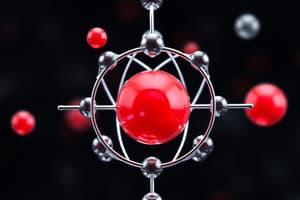Podcast
Questions and Answers
What particles make up an atom?
What particles make up an atom?
- Protons, neutrons, and positrons
- Electrons, muons, and hadrons
- Protons, electrons, and neutrinos
- Protons, neutrons, and electrons (correct)
Which particle is responsible for the positive charge of the atom?
Which particle is responsible for the positive charge of the atom?
- Neutron
- Electron
- Proton (correct)
- Nucleus
What is the approximate relative mass of a neutron in atomic mass units (amu)?
What is the approximate relative mass of a neutron in atomic mass units (amu)?
- 1.009 amu (correct)
- 1.6750 amu
- 0.0005 amu
- 1.0002 amu
How does the charge of an electron compare to a proton?
How does the charge of an electron compare to a proton?
Where are electrons located in an atom?
Where are electrons located in an atom?
What accounts for the mass of an atom?
What accounts for the mass of an atom?
Which ion is not part of the isoelectronic series along with O2-, F–, Ne, Mg2+, and Al3+?
Which ion is not part of the isoelectronic series along with O2-, F–, Ne, Mg2+, and Al3+?
What is the charge of a neutron?
What is the charge of a neutron?
Which statement about the number of electrons in an atom is true?
Which statement about the number of electrons in an atom is true?
What characterizes a covalent bond?
What characterizes a covalent bond?
Which of the following pairs of atoms would most likely form a polar covalent bond?
Which of the following pairs of atoms would most likely form a polar covalent bond?
How are double covalent bonds formed?
How are double covalent bonds formed?
What typically signifies the stability of covalent bonds?
What typically signifies the stability of covalent bonds?
In which of the following statements is a characteristic of a single covalent bond?
In which of the following statements is a characteristic of a single covalent bond?
What kind of charge separation occurs in a polar covalent bond?
What kind of charge separation occurs in a polar covalent bond?
Which of the following describes the general behavior of covalent bonds in living systems?
Which of the following describes the general behavior of covalent bonds in living systems?
What is the primary factor that determines the strength of dipole-induced dipole interactions?
What is the primary factor that determines the strength of dipole-induced dipole interactions?
Which of the following best describes London forces?
Which of the following best describes London forces?
What condition is necessary for an ionic bond to form between a metal and a nonmetal?
What condition is necessary for an ionic bond to form between a metal and a nonmetal?
How is bond dissociation energy defined?
How is bond dissociation energy defined?
What happens to a nonpolar molecule during interaction with a polar molecule?
What happens to a nonpolar molecule during interaction with a polar molecule?
What characteristic of an ionic bond is affected by the size and charge of the ions involved?
What characteristic of an ionic bond is affected by the size and charge of the ions involved?
Which of the following describes ionic substances accurately?
Which of the following describes ionic substances accurately?
What is the significance of the geometry and complexity of molecules in relation to London forces?
What is the significance of the geometry and complexity of molecules in relation to London forces?
What is the primary reason ionic bonds in a cell are generally weak?
What is the primary reason ionic bonds in a cell are generally weak?
Which of the following best describes a coordinate bond?
Which of the following best describes a coordinate bond?
Which interaction is characterized by a dipole attracting another dipole?
Which interaction is characterized by a dipole attracting another dipole?
What does the dipole moment (μ) represent in a molecule?
What does the dipole moment (μ) represent in a molecule?
In an ion-dipole interaction, which factor does not influence the strength of the interaction?
In an ion-dipole interaction, which factor does not influence the strength of the interaction?
Van der Waals forces are primarily characterized by which of the following?
Van der Waals forces are primarily characterized by which of the following?
How is an ion-induced dipole interaction defined?
How is an ion-induced dipole interaction defined?
In polar molecules, what do the positive and negative poles represent?
In polar molecules, what do the positive and negative poles represent?
What is the atomic weight of Boron based on its isotopic composition?
What is the atomic weight of Boron based on its isotopic composition?
Which of the following statements about isotopes is true?
Which of the following statements about isotopes is true?
Which isotope is NOT radioactive?
Which isotope is NOT radioactive?
From the listed isotopes of hydrogen, which one is radioactive?
From the listed isotopes of hydrogen, which one is radioactive?
What decay product does Tritium produce?
What decay product does Tritium produce?
Which of the following pairs correctly identifies the decay of Carbon-14?
Which of the following pairs correctly identifies the decay of Carbon-14?
What is formed when an electron is added to a neutral atom?
What is formed when an electron is added to a neutral atom?
Which statement about the isotopes of Hydrogen is correct?
Which statement about the isotopes of Hydrogen is correct?
What occurs when an atom gains one or more electrons?
What occurs when an atom gains one or more electrons?
Which of the following factors contributes to an atom's electronegativity?
Which of the following factors contributes to an atom's electronegativity?
How does ionization energy behave across the periodic table?
How does ionization energy behave across the periodic table?
What is the definition of electron affinity?
What is the definition of electron affinity?
In terms of atomic structure, what does the principal quantum number (n) indicate?
In terms of atomic structure, what does the principal quantum number (n) indicate?
Which statement about angular momentum quantum number (l) is true?
Which statement about angular momentum quantum number (l) is true?
What is the range of values for the magnetic quantum number (m1) when l=2?
What is the range of values for the magnetic quantum number (m1) when l=2?
Which type of element typically exhibits a high electron affinity?
Which type of element typically exhibits a high electron affinity?
Flashcards
London Dispersion Forces
London Dispersion Forces
Weak intermolecular forces caused by temporary/instantaneous dipoles in molecules, arising from electron movement.
Dipole-induced dipole interaction
Dipole-induced dipole interaction
Interaction between a polar and nonpolar molecule, where the polar molecule induces a dipole in the nonpolar molecule.
Bond Length
Bond Length
Distance between the nuclei of two bonded atoms.
Bond Dissociation Energy
Bond Dissociation Energy
Signup and view all the flashcards
Ionic Bonding
Ionic Bonding
Signup and view all the flashcards
Ionic Compound
Ionic Compound
Signup and view all the flashcards
Electronegativity
Electronegativity
Signup and view all the flashcards
Cation
Cation
Signup and view all the flashcards
Isoelectronic Series
Isoelectronic Series
Signup and view all the flashcards
Covalent Bonding
Covalent Bonding
Signup and view all the flashcards
What are the 6 most common atoms in living systems?
What are the 6 most common atoms in living systems?
Signup and view all the flashcards
Polar Covalent Bond
Polar Covalent Bond
Signup and view all the flashcards
Single Covalent Bond
Single Covalent Bond
Signup and view all the flashcards
Double Covalent Bond
Double Covalent Bond
Signup and view all the flashcards
Why are covalent bonds stable?
Why are covalent bonds stable?
Signup and view all the flashcards
How do atoms in a covalent bond achieve stability?
How do atoms in a covalent bond achieve stability?
Signup and view all the flashcards
Proton
Proton
Signup and view all the flashcards
Electron
Electron
Signup and view all the flashcards
Neutron
Neutron
Signup and view all the flashcards
Atomic Nucleus
Atomic Nucleus
Signup and view all the flashcards
Atomic Structure
Atomic Structure
Signup and view all the flashcards
Electron Cloud
Electron Cloud
Signup and view all the flashcards
How many electrons are in an atom?
How many electrons are in an atom?
Signup and view all the flashcards
Coordinate Bond
Coordinate Bond
Signup and view all the flashcards
Van der Waals Forces
Van der Waals Forces
Signup and view all the flashcards
Dipole Moment
Dipole Moment
Signup and view all the flashcards
Dipole-dipole Interaction
Dipole-dipole Interaction
Signup and view all the flashcards
Ion-dipole Interaction
Ion-dipole Interaction
Signup and view all the flashcards
Ion-induced Dipole Interaction
Ion-induced Dipole Interaction
Signup and view all the flashcards
What makes Ion-dipole stronger than Dipole-dipole?
What makes Ion-dipole stronger than Dipole-dipole?
Signup and view all the flashcards
How do van der Waals forces contribute to protein structure?
How do van der Waals forces contribute to protein structure?
Signup and view all the flashcards
Isotope
Isotope
Signup and view all the flashcards
Atomic Weight
Atomic Weight
Signup and view all the flashcards
Radioactive Isotope
Radioactive Isotope
Signup and view all the flashcards
Radioactive Isotope Uses
Radioactive Isotope Uses
Signup and view all the flashcards
Forming Ions
Forming Ions
Signup and view all the flashcards
Ionization Energy
Ionization Energy
Signup and view all the flashcards
Electron Affinity
Electron Affinity
Signup and view all the flashcards
Quantum Numbers
Quantum Numbers
Signup and view all the flashcards
Principal Quantum Number (n)
Principal Quantum Number (n)
Signup and view all the flashcards
Angular Momentum Quantum Number (l)
Angular Momentum Quantum Number (l)
Signup and view all the flashcards
Magnetic Quantum Number (m1)
Magnetic Quantum Number (m1)
Signup and view all the flashcards
Study Notes
Atomic Structure
- Atoms are the basic units of matter composed of a dense nucleus containing protons and neutrons, surrounded by electrons.
- Protons have a positive charge, neutrons have no charge, and electrons have a negative charge.
- The number of protons in an atom's nucleus defines the atomic number (Z).
- The mass number (A) is the sum of protons and neutrons in an atom.
- Isotopes are atoms of the same element with different numbers of neutrons.
- Atoms are extremely small.
Atomic Structure: Key Terms
- Mass number (A): Sum of protons and neutrons.
- Atomic number (Z): Number of protons.
- Atomic mass: Average mass of all isotopes of an element.
- Isotopes: Atoms of the same element with different numbers of neutrons.
Atomic Structure: Isotopes
- Isotopes have the same number of protons (and thus atomic number) but different numbers of neutrons, resulting in different mass numbers.
- The average atomic mass listed for elements on the periodic table is an average of the different isotopes that occur naturally.
Atomic Structure: Atomic Mass
- It's the weighted average of all naturally occurring isotopes of an element.
- Example: Boron has two isotopes (Boron-10 and Boron-11).
Atomic Structure: Radioisotopes
- Unstable isotopes that decay, emitting energy or particles until they become stable.
- Used in various applications, from medical imaging to dating fossils.
Atomic Structure: Ions
- Atoms that have lost or gained electrons, resulting in a positive or negative charge.
- Cations are positively charged ions (loss of electrons).
- Anions are negatively charged ions (gain of electrons).
Atomic Structure: Electronic Configuration
- Represents the arrangement of electrons in energy levels and sublevels.
- Electronic configuration is written e.g. 1s2 2s2 2p6 - this shows the filling pattern of the energy levels and sub-levels.
- The periodic table can be used to predict electronic configurations.
Electronegativity
- Measure of an atom's ability to attract shared electrons in a chemical bond.
- Higher electronegativity means stronger attraction for electrons.
- Trend in the periodic table: Electronegativity generally increases across a period and decreases down a group.
Chemical Bonding
- Forces that hold atoms together in molecules or compounds.
- Covalent bonds: Sharing of electrons between atoms.
- Ionic bonds: Transfer of electrons to form oppositely charged ions which attract.
- Polar bonds: Unequal sharing of electrons in a covalent bond, creating partial charges.
- Non-polar bonds: Equal sharing of electrons in a covalent bond.
- Hydrogen bonds: Weak forces between a hydrogen atom bonded to a highly electronegative atom and another electronegative atom.
- Van der Waals forces: Weak attractive forces between molecules; momentary instantaneous dipoles.
Types of Bonds
- Covalent Bonds: Electrons are shared between atoms resulting in a molecule
- Ionic Bonds: Electrons are transferred from one atom to another resulting in ions.
- Metallic Bonds: Electrons are shared among many atoms.
Studying That Suits You
Use AI to generate personalized quizzes and flashcards to suit your learning preferences.




